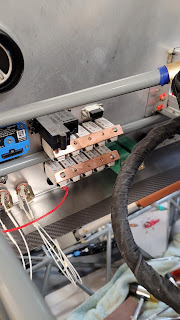The hoses to the differential pressure sensor were were connected and torqued. There is a 4An line running to a T-fitting near the fuel filter, and a 3AN line runs from the back of the sensor to the airbox.
 |
| Differential Pressure Sensor on firewall |
All fuel fittings from the firewall pass-thru to the engine were torqued and marked with torque seal.
 |
| Fuel and fuel filter lines torqued |
The fuse box, which is attached to the firewall, was rotated 180 degrees so that the connectors are now pointed down. The manual does not specifically call out an orientation, but this is the placement that most builders are using. This orientation should help prevent any moisture from seeping into the enclosure through the connector openings.
Many other hoses forward the firewall were tightened and torqued to the appropriate value, then marked with orange torque seal. This included all other fuel lines, oil lines, and an air line running from the differential pressure sensor to the airbox. A few silicone isolation pads were attached at points where there was any possibility of rubbing. Also a few wire-ties were added to keep hoses and cables in place.
 |
| 3AN line to airbox torqued |
 |
| Oil lines torqued to the oil cooler. Red protective pad attached to oil line. |
 |
| Oil lines running to thermostat torqued and marked |
Since our firewall is titanium, the general recommendation is to use stainless steel fasteners instead of cadmium-plated steel in order to prevent potential galvanic corrosion. Because of this, we replaced several of the fasteners on the firewall with stainless steel parts. The most difficult replacement was a couple of larger spacer washers at the bottom of the firewall which were very tight, but we got 'er done.
Hours: 17
 |
| Several firewall fasteners replaced with stainless steel parts |
 |
| Washers between firewall and frame replaced |





















